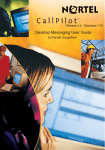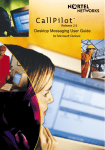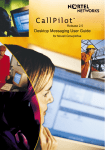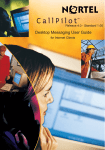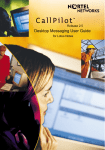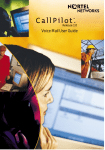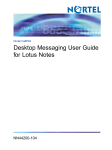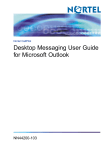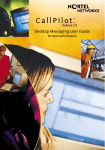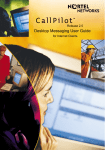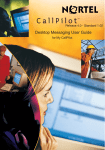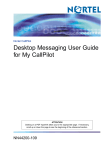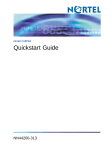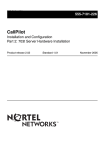Download callpilot desktop messaging user guide
Transcript
CallPilot TM Release 4.0 - Standard 1.06 Desktop Messaging User Guide for Microsoft Outlook CallPilot Desktop Messaging User Guide for Microsoft Outlook Document number: Product release: Document release: Date: 555-7101-422 4.0 Standard 1.06 October 2006 Copyright © 2006 Nortel Networks. All Rights Reserved. Information is subject to change without notice. Nortel Networks reserves the right to make changes in design or components as progress in engineering and manufacturing may warrant. The process of transmitting data and call messaging between CallPilot and its servers, switches or system is proprietary to Nortel Networks. Any other use of the data and the transmission process is a violation of the user license unless specifically authorized in writing by Nortel Networks prior to such use. Violations of the license by alternative usage of any portion of this process or the related hardware constitutes grounds for an immediate termination of the license and Nortel Networks reserves the right to seek all allowable remedies for such breach. Nortel Networks and third-party trademarks appear on the following pages: 2 *Nortel Networks, the Nortel Networks logo, the Globemark, and Unified Networks, BNR, CallPilot, DMS, DMS-100, DMS-250, DMS-MTX, DMS-SCP, DPN, Dualmode, Helmsman, IVR, MAP, Meridian, Meridian 1, Meridian Link, Meridian Mail, Norstar, SL-1, SL-100, Succession, Supernode, Symposium, Telesis, and Unity are trademarks of Nortel Networks. 3COM is a trademark of 3Com Corporation. ACCENT is a trademark of Accent Software International Ltd. ADOBE is a trademark of Adobe Systems Incorporated. AMDEK is a trademark of Amdek Corporation. AT&T is a trademark of American Telephone and Telegraph Corporation. ATLAS is a trademark of Quantum Corporation. ATRIA is a trademark of Pure Atria Corporation. BLACKBERRY is a trademark of Research in Motion Limited. CASEWARE is a trademark of Caseware International, Inc. CONTINUUS is a trademark of Continuus Software Corporation. CRYSTAL REPORTS is a trademark of Seagate Software Inc. DEFINITY is a trademark of Avaya Inc. DIALOGIC, INTEL and VOICEBRIDGE are trademarks of Intel Corporation. DIVX is a trademark of DivXNetworks, Inc. EUDORA and QUALCOMM are trademarks of Qualcomm, Inc. eTrust and InoculateIT are trademarks of Computer Associates Think Inc. DIRECTX, EXCHANGE.NET, FRONTPAGE, INTERNET EXPLORER, LINKEXCHANGE, MICROSOFT, MICROSOFT EXCHANGE SERVER, MS-DOS, NETMEETING, OUTLOOK, POWERPOINT, VISUAL STUDIO, WINDOWS, WINDOWS MEDIA, and WINDOWS NT are trademarks of Microsoft Corporation. GROUPWISE and NOVELL are trademarks of Novell Inc. HITACHI is a trademark of Hitachi Limited. LOGITECH is a trademark of Logitech, Inc. LUCENT is a trademark of Lucent Technologies, Inc. MATRA is a trademark of Matra Hachette. MCAFFEE and NETSHIELD are trademarks of McAfee Associates, Inc. MYLEX is a trademark of Mylex Corporation. NET2PHONE is a trademark of Net2Phone, Inc. NETOPIA is a trademark of Netopia, Inc. NETSCAPE COMMUNICATOR is a trademark of Netscape Communications Corporation. NOTES is a trademark of Lotus Development Corporation. NORTON ANTIVIRUS and PCANYWHERE are trademarks of Symantec Corporation. POWERQUEST is a trademark of PowerQuest Corporation. 3 PROMARK and RHOBOT are trademarks of DMI Promark, Inc. QUICKTIME is a trademark of Apple Computer, In. RADISYS is a trademark of Radisys Corporation. ROLM is a trademark of Siemens ROLM Communications Inc. SLR4, SLR5, and TANDBERG are trademarks of Tandberg Data ASA. SONY is a trademark of Sony Corporation. SYBASE is a trademark of Sybase, Inc. TEAC is a trademark of TEAC Corporation. UNIX is a trademark of X/Open Company Limited. US ROBOTICS, the US ROBOTICS logo, and SPORTSTER are trademarks of US Robotics. WINAMP is a trademark of Nullsoft, Inc. WINRUNNER is a trademark of Mercury Interactive Corporation. WINZIP is a trademark of Nico Mark Computing, Inc. 4 Contents How to get Help . . . . . . . . . . . . . . . . . . . . . . . . . . . . . . . . . . . . . . .7 Welcome to CallPilot . . . . . . . . . . . . . . . . . . . . . . . . . . . . . . . . . . .9 Getting started . . . . . . . . . . . . . . . . . . . . . . . . . . . . . . . . . . . . . . .10 Logging in . . . . . . . . . . . . . . . . . . . . . . . . . . . . . . . . . . . . . . . . . .11 Working with your CallPilot messages . . . . . . . . . . . . . . . . . . . . .12 Playing voice messages . . . . . . . . . . . . . . . . . . . . . . . . . . . . . . .13 Viewing fax messages . . . . . . . . . . . . . . . . . . . . . . . . . . . . . . . . .15 Composing voice messages . . . . . . . . . . . . . . . . . . . . . . . . . . . .16 Composing fax and text messages . . . . . . . . . . . . . . . . . . . . . . .18 Creating and sending fax batch messages . . . . . . . . . . . . . . . . .20 Using custom fax Cover Pages . . . . . . . . . . . . . . . . . . . . . . . . . .27 Initiating a call using Call Directory . . . . . . . . . . . . . . . . . . . . . . .32 Contacting the sender of a message . . . . . . . . . . . . . . . . . . . . . .34 Adding attachments to messages . . . . . . . . . . . . . . . . . . . . . . . .35 Setting message options . . . . . . . . . . . . . . . . . . . . . . . . . . . . . . .35 Forwarding and replying to messages . . . . . . . . . . . . . . . . . . . . .36 Message Forwarding Rule . . . . . . . . . . . . . . . . . . . . . . . . . . . . . .37 Addressing messages . . . . . . . . . . . . . . . . . . . . . . . . . . . . . . . . .38 Personal Distribution Lists . . . . . . . . . . . . . . . . . . . . . . . . . . . . . .45 Instant Messaging . . . . . . . . . . . . . . . . . . . . . . . . . . . . . . . . . . . .46 Changing your mailbox settings . . . . . . . . . . . . . . . . . . . . . . . . . .50 Changing mail delivery settings . . . . . . . . . . . . . . . . . . . . . . . . . .51 Changing your Address Book settings . . . . . . . . . . . . . . . . . . . . .53 Changing audio settings . . . . . . . . . . . . . . . . . . . . . . . . . . . . . . .55 Linking to My CallPilot . . . . . . . . . . . . . . . . . . . . . . . . . . . . . . . . .56 Working offline . . . . . . . . . . . . . . . . . . . . . . . . . . . . . . . . . . . . . . .58 Document information . . . . . . . . . . . . . . . . . . . . . . . . . . . . . . . . .59 5 6 How to get Help This section explains how to get help for Nortel products and services. Getting Help from the Nortel Web site The best way to get technical support for Nortel products is from the Nortel Technical Support Web site: http://www.nortel.com/support This site provides quick access to software, documentation, bulletins, and tools to address issues with Nortel products. More specifically, the site enables you to: download software, documentation, and product bulletins search the Technical Support Web site and the Nortel Knowledge Base for answers to technical issues sign up for automatic notification of new software and documentation for Nortel equipment open and manage technical support cases Getting Help over the phone from a Nortel Solutions Center If you don’t find the information you require on the Nortel Technical Support Web site, and have a Nortel support contract, you can also get help over the phone from a Nortel Solutions Center. In North America, call 1-800-4NORTEL (1-800-466-7835). Outside North America, go to the following Web site to obtain the phone number for your region: http://www.nortel.com/callus Getting Help from a specialist by using an Express Routing Code To access some Nortel Technical Solutions Centers, you can use an Express Routing Code (ERC) to quickly route your call to a specialist in your Nortel product or service. To locate the ERC for your product or service, go to: http://www.nortel.com/erc Getting Help through a Nortel distributor or reseller If you purchased a service contract for your Nortel product from a distributor or authorized reseller, contact the technical support staff for that distributor or reseller. 7 8 Welcome to CallPilot CallPilot* from Nortel is an advanced business communications system that offers exceptional flexibility for managing your messaging needs. You can work with CallPilot from your telephone or your computer. Desktop Messaging gives you access to your CallPilot mailbox through your Microsoft Outlook e-mail. Here are some of the many ways you can use CallPilot with your e-mail: Listen to voice messages. View and print fax messages. Record and send voice messages. Create and send fax messages, including batch faxes. Forward and reply to voice and fax messages. Contact the sender of a message. Add message options such as urgent and private. Add voice, fax, or text file attachments to messages. Start an Instant Messaging session from a message. Create personal distribution lists. Change your CallPilot password. Access web-based My CallPilot to view user information and change your feature settings. Some features mentioned in this guide may not be available for your CallPilot mailbox. For details, refer to the Feature availability topic in the Desktop Messaging online Help, or ask your administrator. 9 Getting started About this guide This user guide describes how to use CallPilot with your Microsoft Outlook e-mail. The instructions and screen images shown in this guide provide general information for using CallPilot with your e-mail. Specific details can vary depending on your computer operating system, the version of Outlook you are using, and the features available for your CallPilot mailbox. For further assistance in using CallPilot, refer to the Desktop Messaging online Help. What you need Before you start to use CallPilot, your administrator ensures that your e-mail account is correctly configured for CallPilot. Your computer must be set up according to the following requirements: CallPilot Player to play and record voice messages Nortel Fax Driver to create faxes Microsoft Outlook 2000, Microsoft Outlook 2002 (XP), or Microsoft Outlook 2003 Windows 2000 Professional or Windows XP Professional Monitor with 256-color 800 x 600 capability 15 Mbytes of free disk space to install software Sound card and speakers for playing voice messages on your computer Microphone connected to your computer, or a telephone situated near your computer, for recording voice messages LAN (Ethernet), ISDN, ADSL, or dial-up modem connection to the CallPilot server for accessing CallPilot messages Internet Explorer 6.0; Netscape 6.2, 7.0, 7.1, 7.2; or Mozilla 1.7.x and Mozilla FireFox 1.0 on RedHat Linux 9 Operating System to access My CallPilot 10 Logging in When you log in to your e-mail, you can log in to CallPilot at the same time. To log in from Microsoft Outlook 1 Open your Microsoft Outlook e-mail. The CallPilot Logon dialog box appears. 2 In Mailbox, type or select your mailbox number. 3 In Password, type your CallPilot password. 4 Check Remember password if you want CallPilot to log in automatically. 5 Click OK. Note: Do not leave the Remember password box checked on a shared computer. To log out When you exit Microsoft Outlook, you automatically log out from CallPilot. Remote login You can log in to your mailbox from any computer that has CallPilot installed and configured in the same way as your office computer. For example, you can use a computer set up for guest access, or your home computer with a dial-up connection to the server. 11 Working with your CallPilot messages When you open your e-mail with CallPilot installed, your CallPilot messages appear in the CallPilot Message Store. The Message Store contains folders for your CallPilot Inbox, Outbox, Sent Items, and Deleted Items. Your CallPilot Inbox Call Directory Contact sender CallPilot Message Store Compose new message Urgent message Attached files voice, fax, text Message was opened by the recipient New message Message was received To check for new messages The CallPilot message waiting indicator in the notification area of your taskbar turns red when you have a new message. To turn the indicator on or off, see Changing mail delivery settings, page 51. New messages appear in bold. To open a message To open a CallPilot message, double-click anywhere on the message line. See Playing voice messages, page 13, and Viewing fax messages, page 15. To delete a message To delete a CallPilot message in your Inbox, click on the message to select it, then click the Delete icon on the toolbar. You can also click the Delete icon in an open CallPilot message. The deleted message moves to the Deleted Items folder. When you log out, or click Exit from Outlook, your CallPilot messages in the Deleted Items folder are immediately deleted without confirmation. To organize your messages To organize your messages, you can create new CallPilot folders in the CallPilot Message Store, and move your messages to these folders. You can access these message when you log in by telephone or through My CallPilot. 12 Playing voice messages When you open a voice-only message, the CallPilot Player appears. In mixed voice, fax, or text messages, click the Voice icon to open the CallPilot Player. To select your telephone or computer to play voice messages You can choose to play your voice messages from your telephone or your computer. To change from one to the other, or to change the telephone number that CallPilot dials, see Changing audio settings, page 55. You can also click the Telephone or Computer icon on the CallPilot Player to change the setting. To play a message from your telephone 1 2 3 To play a voice message when your telephone is selected for playback, doubleclick the message in your CallPilot Inbox, and answer your telephone when the telephone rings. Use the buttons on the CallPilot Player to play or stop the message, go backward and forward, and contact the sender. When you are finished, hang up, and close the message. To play a message from your computer 1 2 To play a voice message when your computer is selected for playback, doubleclick the message in your CallPilot Inbox. The message plays through your computer speakers or your headphones. Use the buttons on the CallPilot Player to play or stop the message, go backward and forward, adjust the volume and speed, and contact the sender. 13 3 When you are finished, close the message. Close message Address Position in message Play/ Replay Status Stop Record Message Disconnect Contact the Sender Play messages from telephone Play messages from computer Adjust volume Go to start/ Skip back Go to end/ Adjust Skip forward speed 14 Viewing fax messages Note: In order to receive faxes, your CallPilot administrator must enable fax capability for your mailbox. To view a fax message 1 2 3 Double-click a fax message in your CallPilot Inbox. When you open a fax-only message, the fax image appears right away. In mixed voice, fax or text messages, click the Fax icon to view the fax. While viewing the fax, you can enlarge or reduce the image, rotate or move the fax, print the fax, delete the fax, save the fax, add a voice annotation to the saved file, forward the fax, and reply to the fax. When you are finished, close the message. Close message Open next or previous message Print Delete message Forward Reply to All Reply Select part of image Change page views Drag/scroll image Go to next or previous page Rotate left Rotate right Zoom in Zoom out 15 Composing voice messages You can record a voice message from the computer or the telephone, then address and send the voice message, the same way as an e-mail message. To record and send a voice message 1 2 In your CallPilot Inbox, click the New CallPilot Message icon . On the new message form, click the Telephone icon in the toolbar to open the CallPilot Player, if the CallPilot Player is not already open. 3 On the CallPilot Player, click the red Record button to start recording. 4 If you are recording from the computer, record your message into the microphone. Click Stop to end the recording. Click Play to review it. To add to the recording, click Record, speak again, then click Stop. If you are recording from the telephone, answer when the telephone rings. At the tone, record your message. Click Stop to end the recording. Click Play to review it. 5 Click To… to address from the CallPilot, e-mail, or any Address Book. See Addressing messages, page 38. Or type a formatted address in the To... text box. 6 Add attachments and options if required. See Adding attachments to messages, page 35, and Setting message options, page 35. 7 On the toolbar, click the Send Message icon. Note: Insure that rich text format (RTF) format is selected in your e-mail client, if plain text is selected the message delivery may fail. Send message Attach file Save message Telephone icon opens CallPilot Player Address message Set options Playback slider Play Stop Record from telephone Record from computer Record Adjust volume Go to start/ Go to end/ Adjust speed To save a newly created voice message as a file 1 2 On a new message form, record a message, and on the File menu, click Save as... In the File name box, type a name for the file, select a folder in which to keep the file, then click Save. Save voice files as .vbk files. Note: CallPilot automatically 16 converts .vbk files to .wav files, when sending to non-CallPilot users. See Changing mail delivery settings, page 51. 17 Composing fax and text messages To create and send a single fax message To create a fax, your CallPilot mailbox must have the fax capability enabled. The CallPilot recipients of your fax must also have fax capability to view the fax on their computer. If your recipients access their messages from their telephone, they can view the fax only by printing it. You can also send your fax to a fax machine. 1 Open the document that you want to fax. The document must be no greater than 8.5 in. (21.5 cm) in width. 2 On the File menu, select Print. 3 From the list of printers, select Nortel Fax, then click Print or OK. 4 The Compose Fax dialog box appears. Before sending the fax, you can add more documents by repeating steps 1 to 3. You can also choose to include a cover page, view the fax, and save the fax as a file for later transmission. 5 Select an appropriate Send using... option. To send a simple fax, type the fax machine numbers, or CallPilot mailbox number (append the letter “m” to the CallPilot mailbox number, for example, m7366), in the Fax machine(s) text box, type a subject in the Subject text box, then click Send. To send your fax as an attachment to a new CallPilot message, select CallPilot Desktop Messaging for Microsoft Outlook under Send using, then click Send. View before sending File name Delete before sending Send fax options Change order of files to be faxed Cover page option selection Save to send later 6 7 A new message form opens with your fax file attached. Address the message from CallPilot, e-mail, or any Address Book. See Addressing messages, page 38. Or type the formatted address in the To... text box. Add attachments and options if required. See Adding attachments to messages, page 35, and Setting message options, page 35. Click Send Message. 18 To create and send a text message To create a text message: 1 2 3 4 5 Open a new CallPilot message form. Click the Text icon in the toolbar. Type or paste plain text into the message. Address the message. Click the Send Message icon. 19 Creating and sending fax batch messages To send customized CallPilot fax messages to multiple recipients, you can use Microsoft Word Mail Merge, and send your print job to the Nortel Fax Batch printer. You must be familiar with Microsoft Word Mail Merge functionality to use this feature. Consult your Microsoft Word documentation. Note that the CallPilot Fax Batch feature is only available to CallPilot Desktop and web users who install the Nortel Fax Batch Print Driver. To use Mail Merge with CallPilot, you need your main document (the file you want to send to your recipients) and a data source document that contains recipient information, such as names and fax numbers. Your CallPilot Desktop Messaging installation includes a sample Microsoft Word data source document named Data.doc and, a sample Microsoft Word main document named Sample.doc. Accessing and modifying the sample Data source document The Data.doc file consists of a Microsoft Word table, organized in columns, with one row for each recipient. The following column headers exist in the sample: ToFax, ToName, DelReceipt, DelType, ToCompany, and ToPhone. These column headers can be modified and deleted, and new columns can be added. The column header names serve as tags, which can be inserted into the main document, to customize the fax for each recipient, or to direct CallPilot how to handle the fax. 1 Go to \Program Files\Nortel\CallPilot\fax directory, and open the Data.doc file. 20 2 3 Add new columns or subtract existing ones, as required. For new columns, chose a meaningful column header name. Add the required data under each column header. The data source can be created by any means available to populate a Microsoft Word table, including importing information from existing files. If you edit the recipient list using the Mail Merge utility (that is, click Edit in the Data source section of the Microsoft Mail Merge Helper), the Data Form window opens and lists all the entries from the data source table. You can add, delete, modify, and search for records in this window. Any column headers that you added or modified in the data source file automatically appear in this window. Note that the ToFax text box is the only mandatory text box for CallPilot. The following parameters and characters are supported in the ToFax text box: Maximum supported length for the fax phone number is 120 characters. Numbers 0 through 9 are supported. Uppercase and lowercase P and the comma is used when a pause is necessary. The Pound sign (#) is supported. Common phone number symbols such as left and right parentheses and the dash, are supported. Spaces are supported. When placed before a CallPilot mailbox number, to designate the mailbox address, the M is not case-sensitive. The other text boxes are optional, and are used to customize, or to direct CallPilot how to handle, the fax. Three specific CallPilot text boxes and their parameters are: ToName: This is the fax recipient’s name, and can be up to 256 characters in length. DelReceipt: You can use this tag to receive a Delivery Receipt in the form of a CallPilot message in your CallPilot mailbox, when the fax is delivered to the recipient. If the DelReceipt text box is set to 1, then a delivery receipt is generated. If DelReceipt is set to 0, a delivery receipt is not generated for that recipient. If the DelReceipt text box is empty, or the field is not in Data.doc, then no delivery receipt is generated. DelType: This text box is used to set a delivery priority for each recipient. If the DelType text box is set to 0 or is left empty (or if DelType Text Box is not present in your Data.doc), the message is tagged for Normal delivery. If DelType is set to 1, then the message is tagged for Economy delivery. If DelType is set to 2, then the message is tagged for Urgent delivery. Messages sent to non-CallPilot recipients with the Delivery Type set to Economy is delivered on a schedule defined by the CallPilot server for Economy delivery. Note that messages sent to CallPilot mailboxes are not affected by the Economy designation, and is sent as Normal messages. Transmission of messages tagged as Normal or Urgent begin immediately. The Urgent icon is displayed from My CallPilot or a Desktop Messaging 21 4 5 client and a voice prompt identifies the message as Urgent from the CallPilot telephone interface. Messages sent Urgent are treated as Normal when they are sent to non-CallPilot addresses. When the table is updated, save all changes. You normally supply a unique name for your data file here; however, for the remainder of these procedures, the name Data.doc is used. Close the document. The Data.doc file can now be used as a data source by Microsoft Mail Merge. Accessing and modifying the sample Main document The Sample.doc file is an example of a Microsoft Word main document. 1 From the \Program Files\Nortel\CallPilot\fax directory, open Sample.doc in Microsoft Word. This document contains tagged fields corresponding to those in the example Data.doc file. You can use the example Data.doc as a template for your own fax, or for practice purposes. If you modify the column header names in Data.doc, you must modify them in your main document as well. First page The first page of the main document is a special page, and does not become part of the final fax. Sample.doc is installed with the first page set up correctly. 22 The purpose of this page is to provide a location to map information in the data source to each customized fax document. To signal CallPilot that this is a Fax Batch file, and to prevent this page from becoming part of the fax, two special control codes must be present on the first page: $SOJ$ Start of Job, signals the fax driver to start processing, and can be placed anywhere on the first page. /zz Start this page, prevents the first page from becoming part of the fax message, and can be placed anywhere on the first page. The CallPilot Desktop software retrieves the Fax Number from the first page of the document. Additionally, CallPilot Desktop software retrieves the Recipient Name, the Delivery Receipt, and the Delivery Type, if they exist on the first page. /tp Fax Number, is used to address the message. This text box is required. /dr Delivery Receipt, is turned on or off for each recipient. This text box is optional. /tn Name of Recipient, is used to identify the record in the Nortel Fax Batch Status dialog if the fax number is either missing or invalid. This text box is optional. /dt Delivery Type, is used to mark messages for Normal, Economy or Urgent delivery. This text box is optional. To complete the page, the Fax Number column header (that is, <<ToFax>>) must be inserted after the /tp control using the Mail Merge insert function. Also, the Delivery Receipt column header (that is, <<DelReceipt>>) can be inserted after the /dr control, the Name of Recipient text box (that is, <<ToName>>) can be inserted after the /tn control, and the Delivery Type text box (that is, <<DelType>>) can be inserted after the / dt control. Note: all Fax Batch controls are case-sensitive. As an advanced fax addressing feature, users can also modify all data in a single column, without actually modifying the data source file. For example, if an existing data source table contains fax numbers for a large number of recipients, but the external access number 9 is missing, this number can be added to all fax numbers by modifying the control on the first page of the document as follows: /tp9<<ToFax>> In this example, a 9 is added to the beginning of each phone number during fax batch processing. The data source remains unchanged, and can be used from a different location that does not require a 9 for external access. Second page When the data source document and the first page of the main document are created, you can customize your fax. Note: The page must be equal to, or less than, 8.5 inches in width. You can use all of the data source column header tags to customize the document. The 23 following is an example using the Sample.doc file: In this example, the document is customized for each recipient. Data source column headers are inserted into the document using the Microsoft Word Mail Merge utility. After the main document is customized, the document is ready to be merged with the information in the Data.doc file. Consult your Microsoft Word Mail Merge help for more details on inserting data source fields into the document. Merging data from the data source into the Main document When you are ready to merge data from the data source file into your main document: 1 2 3 Start Mail Merge from the Microsoft Word Tools menu. Depending on which version of Microsoft Word you are using, Mail Merge is located under different menu headings. a. In the Office XP version, select Tools> Letters and Mailings> Mail Merge Wizard. b. In Office 2000 select Tools> Mail Merge. Verify that Sample.doc is currently selected as the main document, and that Data.doc is currently selected as the data source. Select Merge to Printer, and then select the Nortel Fax Batch driver from the Print dialog box that appears. Note: Ensure that Microsoft Word is not set up to print pages in reverse order. 24 4 Click OK in the Print dialog box to initiate the batch fax process. When the document is merged, data values from the data source file are merged into the main document at the appropriate tag positions, and a separate fax TIF file for each recipient is created. CallPilot Desktop software addresses and transfer the fax files to the server. The CallPilot server is responsible for actually sending the fax to the recipients. Once the process starts, the Print Status dialog box appears. The page number increases incrementally as each page is converted to a TIF file. Because the first page is skipped, this page is not included in the count. For example, if a three-page fax is sent to ten recipients, the dialog box displays "Printing page 1," "Printing page 2," and continues up to "Printing page 20." Only 20 pages are printed, because the first page of each document is skipped. Problems that occur while creating the fax images, or with the fax addresses, are displayed in a separate Nortel Fax Batch Status dialog box: Problems, such as a missing fax address or an unsupported fax address format, is checked. However, problems such as a wrong fax number is not identified, provided the number is in a valid format. A wrong fax number, however, results in the sending of a non-Delivery receipt to the user's CallPilot mailbox by the CallPilot server. When you click the OK button, the batch process ends, and no faxes are sent. You must fix the fax addresses, and resubmit the job. If all faxes and addresses are created properly, a dialog box appears while the faxes are being addressed and transferred to the CallPilot Server. The Nortel Fax Batch Status dialog box indicates the status of the batch job. If you press Cancel in this dialog box before the job is completed, another dialog box appears, asking you to confirm the cancellation. If you select Yes, all temporary files are deleted, and the process ends. However, all faxes that are already transferred to the CallPilot server are sent. If a problem occurs while transferring the fax, a dialog box similar to the following 25 appears: If you select Yes, an attempt is made to resend the fax to the server. If you select No, the current fax is skipped, and processing begins on the next fax in the list. The skipped fax is not sent. If you select Cancel, another dialog box appears, asking you to confirm the cancellation. If you choose Yes, all temporary files are deleted, and the process ends. Any faxes already transferred to the CallPilot server are sent. If you choose No, the failure dialog box shown above is displayed again, allowing you to make a different choice. A confirmation dialog box appears once all faxes have been submitted to the server. 26 Using custom fax Cover Pages CallPilot users can choose to include a cover page with their faxes. The server administrator typically designs and manages these cover pages. The user simply chooses the desired style of cover page (if more than one is available). Cover pages created with these tools include the following information: From Information: To Information: Title Name Department Phone number Fax number Title Department Name Phone number Company Company Fax number Number of Pages Sent Date & Time A Cover Sheet Memo section CallPilot Configuration The Configuration page of CallPilot Desktop Messaging includes an option labeled Include cover page when forwarding fax message. The default value for Include cover page when forwarding fax message is unchecked, meaning that a cover page is not added to the message. If you select this option, you can choose and set a default cover page from a list of available cover pages. Use the Browse… button to choose the location where the cover pages are stored. The default location is: \ \Program Files\Nortel\ CallPilot\cvrpages. 27 CallPilot Desktop Messaging Custom form The Custom Fax Forward form of CallPilot Desktop Messaging contains a menu item named Cover page, which contains two submenus items: Add and Modify. The Add menu displays a list of existing cover pages available to use. Select one of these, and click OK. The Modify menu displays the current cover page content and allows you to modify the current cover page content. From the "Modify" window, you can also preview the current cover page. If you enable the Include cover page… option, CallPilot Desktop Messaging adds the selected cover page to the Fax Forward form. The cover page appears as the first attachment on the list of attachments (left pane). The Attachment view (right pane) contains only the Cover Sheet Memo section of the cover page. You can include any additional required information here. 28 Nortel Fax Printer Driver form You can use the Nortel Fax Printer form to send a fax message, using either a CallPilot Desktop Messaging client (such as Microsoft Outlook) or the QuickFax feature. QuickFax allows you to send a fax directly from the Print dialog box. If you choose to send your fax using a CallPilot Desktop Messaging client, the cover page is available from the CallPilot Custom form. 29 If you choose to send your fax to a specific destination (for example, a fax machine), the Cover page text box becomes active, and allows you to browse, through the use of the Browse button. You can select a cover page from the drop-down list. You can then modify the cover page contents. The modification of the cover page provides functionality similar to the Custom form. (Refer to Modify and Preview cover page for details.) You can also choose not to include a cover page by selecting the No cover page option from the Use fax cover page drop-down list. Note that you can also include a Subject line in the Subject text box. The Subject line information appears in the e-mail portion of the fax, but not on the hard copy of the fax. Modify and Preview cover page You can preview the current cover page, and modify its contents, from both the CallPilot Custom form and the Nortel Fax Printer driver application. Click Preview to view the current state of the cover page. 30 The first time you access this page, CallPilot Desktop Messaging attempts to fill in the From section using information from the registry. Desktop Messaging remembers the data that you entered into this section, and automatically completes those text boxes the next time you use this page. Although the From information is automatically populated from the registry, you can still change it. In the To section, the Fax text box is always read-only. CallPilot populates the Fax text box using address information from the Custom or Fax Driver forms. The Name text box is read-only if the cover page is filled using the Custom form. In this case, CallPilot automatically fills the Name text box using the recipient's name. If you use the Fax Printer driver, this text box is left empty, and you can complete it. If a cover page is used from the Fax Printer driver, CallPilot Desktop Messaging computes the number of pages, and enters this information in the Pages text box. When you use the Custom form, the Pages text box is left empty. You can modify this text box in either case. The Sent text box uses the current time and date by default. This text box is also editable. The Memo section is synchronized with the Memo section of the Custom form. Note: The maximum length of the Memo text box is 2500 characters. The maximum length of the other cover page text boxes is 30 characters. 31 Initiating a call using Call Directory The Call Directory feature allows you to call any person listed in any Address Book available to Microsoft Outlook. This includes the Global Address List, Outlook Contacts, and CallPilot Address Book. To make a call, you select the Call Directory menu item from the Tools->CallPilot Desktop Messaging Tools menu, or press the Call Directory toolbar button. This brings up the Microsoft Outlook Select Names dialog box, which allows you to navigate all Address Books. When a user is selected from the Select Names dialog box, CallPilot attempts to retrieve telephone numbers from the following fields: Assistant Business Business 2 Car Home Home 2 ISDN 32 Mobile Other Contact Verification When CallPilot has extracted all valid telephone numbers, you are prompted to select and validate the telephone number, before a person is called. Any changes made to the number are cached in the registry, if Remember changes is selected. If CallPilot cannot find any valid telephone numbers, then, depending on the client, only the person's e-mail address or name is listed. Because the e-mail address or name cannot be dialed, you must manually enter the person's complete telephone number. The number is cached in the registry, if Remember changes is selected. 33 Contacting the sender of a message You can respond to a CallPilot message or an Microsoft Outlook message with a telephone call instead of a recorded message. When the sender of a message originates from within a Microsoft Exchange Server, the address is known, because the address is listed in your Address Book. When the sender of a message originates from an external SMTP server, the sender appears as Unknown in the Inbox and CallPilot form, regardless of whether the sender is listed in your Address Book. Contacting the sender of a message when the address is known 1 Select a message in your CallPilot or Microsoft Outlook Inbox. 2 Click the Contact Sender toolbar icon. . Because the e-mail sender’s Address Book entry can contain multiple numbers, all telephone numbers that can be found for the sender are presented to you in the Contact dialog box (see dialog box on page 33). Choose the appropriate number, and press the Contact Sender button. The CallPilot Desktop client attempts to remember changes you make, if you select the Remember Changes checkbox. 3 Answer the telephone when the telephone rings. CallPilot immediately calls the sender of the message. 4 When you finish the call, hang up the telephone, or click Disconnect . Note: User can contact the sender by e-mail, or choose a contact from any global or local address list, or a Microsoft Outlook contact. 34 Adding attachments to messages Before sending a message, you can attach one or more voice, fax, or text files to it. Voice files can be .vbk or .wav format for CallPilot recipients; CallPilot can automatically convert .vbk files to .wav files when sending to non-CallPilot users. See Changing mail delivery settings, page 51. Fax files must be .tif format. Text files must be .txt format. To attach a file to a message 1 2 3 On a new message form, click the Attach File icon. In the Open dialog box, select or type the name of the files that you want to attach. Click Open to attach the files, and to return to the new CallPilot message. Setting message options Before sending a message, you can set options for handling and delivery. To set message options 1 On a new message form, select Delivery, Sensitivity, and Receipt options, as required. For Delivery, select Urgent, or leave the setting as Normal. For Sensitivity, select Private, or leave the setting as Public. Note that when you send a message marked Private, recipients can still forward the message to someone else, if they are not a CallPilot users. Also, recipients in nonCallPilot systems are not informed of Private settings. In your message, tell the recipients that the message is Private. For Receipt acknowledgment, check Read receipt to request acknowledgment that recipients opened the message. Check Delivery receipt to request acknowledgment that recipients received the message. 2 Continue to compose, address, and send the message as usual. 35 Forwarding and replying to messages You can forward a message, and append an introduction to it. You can also compose a reply to the sender of a message, or to the sender and all recipients of a message. To forward or reply to a message Compose voice message Compose text message Attach file 1 In an open message, click Forward, Reply or Reply to All. 2 On the new message form, compose a voice, fax, or text message. Address forwarded messages the same way as a new message. Replies are addressed automatically. Add attachments, set options, and change the subject line if required. Click the Send Message icon. 3 4 5 Note: Your administrator can block messages forwarded to external e-mail addresses. 36 Message Forwarding Rule The Message Forwarding Rule can be configured by the system administrator or by the My CallPilot user. The Message Forwarding Rule feature enables you to automatically forward some or all of your CallPilot messages to an address configured by the system administrator. The user must enable the Message Forwarding Rule. If a message cannot be delivered the Message Forwarding Rule is disabled. Once the user receives notice of the undeliverable message, the Message Forwarding Rule, must again be enabled. Messages forwarded from the CallPilot server are delivered to the e-mail account configured in the Message Forwarding Rule. You can treat these messages as any other e-mail. Messages can be forwarded, printed, saved, archived, deleted, and can have rules applied to them. The Message Forwarding Rule must be configured to forward messages to the Microsoft Exchange Server if the messages are to appear in the Microsoft Exchange Server Inbox. Messages reside in the default message store defined by the user. The default message store is typically the Inbox folder on the Microsoft Exchange Server, or the Inbox folder in a local PST database file. Forwarded messages appear as Exchange e-mail messages, and honor all rules that apply to Outlook e-mail messages. Note, however, that there are a few limitations when using the Reply/Reply All functionality. You cannot reply to messages from a sender whose address/CLID is not included in the message, because the address is unknown. Also, because the CallPilot server can accept only plain text messages and attachments of type VBK or TIF-F, you must ensure all outgoing messages addressed to a CallPilot address are composed using these types. If a message is sent to a CallPilot address with a different attachment type, or in a format other than plain text (for example, RTF), you receive an Non-Delivery Notification (NDN). Note also that voice messages sent in VBK format play only if the CallPilot player is installed on the system. Voice messages sent in WAV format require a WAV player capable of playing standard WAV-PCM. Most standard WAV players support this format. Forwarded CallPilot messages are accessible from Outlook Web Access. Forwarded messages honor all rules that apply to Outlook Web Access e-mail messages. The messages are displayed with regular Outlook Web Access e-mail icons, and the standard OWA e-mail form is used to display the message. Note: In order to enable or disable Message Forwarding Rule from the desktop client interface you use your account information in the Address Book advanced section and not an anonymous log on. Note: If the Exchange 6.5 server is used for outgoing SMTP messages, messages Are not marked as Read when they are opened by the recipient because the Read Receipt does not get sent back to CallPilot. You should either use Forwarded by this Service option or turn off Mark original message as Read option when configuring Message Forwarding Rules. 37 Addressing messages To address a message from an Address Book You can address a CallPilot message from the Address Book on the server, or you can select addresses from any available Address Book. The CallPilot Address Book on the server is maintained by your organization, and contains the addresses of the CallPilot users and distribution lists that you are allowed to use. You cannot edit this list. You can download the Address Book to your computer so that you can work in offline mode. See Changing your Address Book settings, page 53. Your Microsoft Outlook Contacts is a list of e-mail addresses that you maintain on your computer. You can add CallPilot addresses to this list. 1 2 3 4 5 In a new CallPilot message, click To… . In the Show names list, select Microsoft Outlook Contacts. Select the name of the recipient or distribution list. Click To ->. You can select one or more addresses, clicking To -> after each one. Click OK to return to the new CallPilot message when the recipients are chosen. E-mail addresses versus Fax/Telephone numbers The CallPilot Desktop client always attempts to find a CallPilot or Microsoft Exchange Server address when sending a message to a recipient. Using either a CallPilot or Microsoft Exchange Server address is the safest mechanism for message transmission, because the entire message is sent without requiring, user interaction. However, if a 38 CallPilot or Microsoft Exchange Server address cannot be found, the Desktop client determines the message data type (voice, TIF, or text), and takes one of the following actions: Mixed Media messages If mixed media is detected (voice/TIF or voice/text; note that TIF/text is not considered mixed media), the message is sent to the recipient's e-mail address. If an e-mail address cannot be found, a Non-Delivery Notification (NDN) is generated for that recipient. The desktop client cannot send mixed media messages to a telephone or fax number. Single Media messages If voice only or tif/text only data is detected, the desktop client scans the recipient for an e-mail address, and telephone and fax numbers. The desktop client scans for telephone numbers if the data is voice only, or for fax numbers if the data is tif/text only. If an e-mail address is found without telephone or fax numbers, the message is sent without additional user interaction. The system generates an NDN if it cannot locate an e-mail address, telephone number, or fax number. If a telephone or fax number is found, the CallPilot Recipient dialog box is displayed, and you are prompted to choose the final destination. You must modify the selected number in the Verify number text box to ensure proper delivery. You can also choose an e-mail address (if available), but cannot modify it. Validating Telephone and Fax Numbers The original telephone or fax number can contain any alphanumeric character. This includes special dialing prefixes, such as + for international numbers, or abbreviations, such as ESN to denote internal calls. However, you must modify the selected number in the Verify number text box of the CallPilot Recipient dialog box to ensure proper delivery. The modified number can contain only the following alphanumeric characters: Numeric characters 0123456789 Numeric delimiters ( ) Pause characters Pp, Pound # White space The CallPilot Desktop client attempts to remember changes you make. This can prevent you from making the same changes each time the same telephone or fax number is used. Note that the ability to dial any telephone or fax number can be restricted by the CallPilot server. Note also that the ability to scan for telephone or fax numbers is only available in the CallPilot Custom form. The standard e-mail form does not scan for these numbers. If a CallPilot or e-mail address is missing from a recipient text box in the standard e-mail form, an NDN is generated for that recipient. 39 To address a message manually You can type an address directly into the To text box of a new message. Enclose the address in square brackets. Refer to the Required format for a CallPilot E-mail address for the correct addressing formats. To add CallPilot addresses to your Outlook Contacts You can add CallPilot addresses and distribution lists to your Outlook Contacts. You can choose to distinguish between CallPilot and e-mail addresses by adding the word CallPilot after the recipient’s name. 1 Open the Address Book from Microsoft Outlook, and click on the New Entry toolbar icon. 2 You then are prompted to select the entry type. Select New Contact to create a new entry in the Microsoft Outlook Address Book. A new Untitled - Contact dialog box is displayed. CallPilot uses two text boxes: contact information and e-mail. 3 You can choose to enter a CallPilot address in the E-mail text box, fax, or telephone numbers in the contact text boxes. You can fill in all text boxes; however, the desktop client ignores all fax and telephone numbers, if the E-mail text box contains a Microsoft Exchange Server or CallPilot Server address. Resolving an unknown address Before you can send a message to an address that appears Unknown, you must find 40 the name of the sender. To do this, use the feature Resolving Addresses. To activate Resolving Addresses functionality in CallPilot Desktop Messaging To activate Resolving Addresses functionality in CallPilot Desktop Messaging, check the Resolve sender and recipients with personal Address Book option. Use the Mail tab of the CallPilot Desktop Messaging Properties dialog box for this. Resolve sender Now, when you receive an incoming message, the system searches your Outlook Contacts to determine if that sender is listed. If the system finds the address of the sender, the display name appears in your Inbox and CallPilot form. You can contact the sender by following the steps for Contacting a sender of a message when the address is known. 41 To add a sender to your Outlook Contacts If the sender is not in your Outlook Contacts, the display name appears as Unknown. You can add a sender to your Outlook Contacts. 1 Right-click in the From field that contains the word “Unknown” in the dialog box CallPilot Form with Unresolved Sender. Four options appear: Properties... display the sender Properties Add to Contacts... add a new contact Contact Sender... display the Contact dialog box, and call or send an instant message to the sender Copy... copy the sender name to the clipboard 42 2 Select Add to Contacts... to add the sender to your Outlook Contacts. The contact window box appears. 3 Insert the name of the sender. 4 Select Save and Close. The new contact is added to your contact list with the name of the sender. Your Inbox is also updated to show the contact name that you entered. Required format for a CallPilot E-mail address If you choose to enter a CallPilot address in the E-mail text box, enter the address in the following format: [CALLPILOT:XXXXYYYY@ZZZZ] 43 Where: XXXX = VPIM network shortcut YYYY = CallPilot Mailbox number ZZZZ = CallPilot Server FQDN (server and domain) For example, suppose CallPilot server na42349 in the domain us.nortel.com with VPIM network shortcut 1952897 contains mailbox 7404. Then the CallPilot address for that mailbox is: [CALLPILOT:[email protected]] Required format for Fax and Telephone Numbers If you choose to enter a fax or telephone number in the contact field(s), it must be entered as an alphanumeric string. Pause (P p ,) and pound (#) characters are supported. The required format for fax is: [CALLPILOT:FAX=XXXX@ZZZZ] The required format for voice is: [CALLPILOT:VOICE=XXXX@ZZZZ] Where: XXXX = Telephone or fax number ZZZZ = CallPilot Server FQDN (server and domain) Examples of valid fax and telephone number formats are: [CALLPILOT:[email protected]] [CALLPILOT:(416) [email protected]] [CALLPILOT:(416) 697-4545,[email protected]] [CALLPILOT:(416) [email protected]] [CALLPILOT:(800) 921-1342#[email protected]] Microsoft Outlook supports telephone and fax contact numbers for business, home, car, etc. Some contact numbers are not supported. Note that contact numbers are a feature of Microsoft Outlook; CallPilot Desktop Messaging cannot hide or alter unsupported items. The supported and unsupported numbers are shown as follows: Valid Voice Contact Numbers: Assistant; Business; Business 2; Car; Home; Home 2; ISDN; Mobile; and, Other valid fax contact numbers Valid Fax Contact Numbers: Business fax; Home fax; and, Other fax Unsupported Contact Numbers: Callback; Company; Pager; Primary; Radio; Telex; and, TTY/TDD 44 Personal Distribution Lists There are two types of Personal Distribution Lists (PDL) you can use: CallPilot PDL, which can be created using My CallPilot or the telephone Local distribution lists, which can be created from Microsoft Outlook Contacts. Note that this type is not accessible from telephone interface. To use existing CallPilot personal distribution lists You can address messages using CallPilot Personal Distribution Lists that you create in My CallPilot or on your telephone. In Outlook, select these lists from the CallPilot Address Book. To create a personal distribution list in Outlook You create a CallPilot Personal Distribution Lists in Outlook the same way that you create an e-mail personal distribution list. When you create a list, the e-mail personal distribution list appears in your-mail Contacts. so that you can select the list to address a message. You cannot access a list created in Outlook from your telephone or from My CallPilot. 1 2 3 4 5 6 7 8 In your Inbox, on the Tools menu, click Address Book. Click New Entry and select Contacts. Select New Distribution List, and click OK. In Untitled-Distribution List, in Name, type a list name. Click Select Members… to display Edit New Distribution List Members. Scroll to CallPilot Address Book and select it. Select names to add to the Distribution List, clicking Members -> after each name. Click OK when you finish entering names. Click OK after viewing the list. You can add or delete names for this list at any time. 45 Instant Messaging The Instant Messaging feature allows you to start an Instant Messaging (IM) session through Microsoft Windows> MSN Messenger and Nortel Multimedia PC Client (MCS 5100) from a CallPilot or e-mail message. You can initiate an Instant Messaging connection with other users, provided both parties have a valid account on MCS 5100 (Nortel Multimedia PC Client), or with one of the following services available in Windows> MSN Messenger: NET Passport Service (Windows> MSN Messenger) SIP Communication Service (Windows Messenger) Exchange Instant Messaging Service (Windows Messenger) There are no special requirements to configure these services. You must configure these accounts according to Windows/MSN Messenger requirements. For the SIP Communication Service on MCS 5100 configuration, you must have a configured and fully-operational Nortel Multimedia PC Client to be able to use its Instant Messaging functionality. To activate Instant Messaging functionality in CallPilot Desktop Messaging To activate Instant Messaging in CallPilot Desktop Messaging, you must select which IM applications to use. Use the General tab of the CallPilot Desktop Messaging Properties dialog box. By default, both applications are not selected. You cannot select an application 46 that is not installed on your PC. Using Instant Messaging from the CallPilot Form You can initiate an instant messaging session through the CallPilot Form. When the CallPilot Form is open, choose the Contact Sender menu item from the Actions menu, or click one of the CallPilot Form toolbar buttons. When Contact Sender is chosen, CallPilot retrieves the message sender's CallPilot address. You are prompted to validate the address in the Contact dialog box. Note: The icons on the toolbar Instant Messaging buttons are different colors, depending on the online status of the sender. These are as follows: Online Offline Status or sender Sign In name Unknown to Windows/MSN Messenger Online Offline Status or sender Sign In name Unknown to Nortel Multimedia PC Client (MCS5100) Tool tips for Instant Messaging buttons also show sender’s Sign In name and online status, if this information is available. 47 Using Instant Messaging from Microsoft Outlook You can initiate an Instant Messaging session by selecting a message and choosing the Contact Sender menu item from the Tools->CallPilot Desktop Messaging Tools menu. When Contact Sender is chosen, CallPilot retrieves the message sender’s CallPilot or e-mail address. You are prompted to validate the address in the Contact dialog box. Contact dialog box With the CallPilot Contact dialog box, you can initiate an Instant Messaging session by using Windows Messenger / MSN Messenger application, or by using the Nortel Multimedia PC Client (MCS 5100). The Contact dialog box displays your Contacts list from either Windows/MSN Messenger application or the Friends list from Multimedia PC Client. Both Windows Messenger / MSN Messenger application and the Nortel Multimedia PC Client require the sender's Sign In name to be present in the Contacts> Friends list before initiating an Instant Messaging session. The sender's CallPilot or e-mail address that is extracted from the message is treated as the sender's Instant Messaging Sign In name. The Contact dialog box attempts to find the sender's Sign In name in the appropriate list. If the search is successful, the Verify sign in name text box is prefilled. Otherwise the text box is left empty and you must manually enter the sender's Sign In name. You are always prompted by the Contact dialog box to validate the sign in name before starting an Instant Messaging session. Any changes made to the number are cached in the registry, if Remember changes is selected. After verifying the sign in name, click the Send button. If the Sign In name is already in the contact list, the Windows Messenger / MSN Messenger, or the Nortel 48 Multimedia PC Client Conversation window, is displayed. This window provides the interface for sending and receiving instant messages. If the Sign In name does not exist in your Contact> Friend list, CallPilot Desktop Messaging attempts to add it. If the name is successfully added, you receive a confirmation. You can then click the Send button to display the Windows Messenger / MSN Messenger or Nortel Multimedia PC Client Conversation dialog box. If the name is not added successfully, the Instant Message is aborted. 49 Changing your mailbox settings To view or change your CallPilot access settings 1 2 3 In your e-mail Inbox, on the Tools menu, click Services (or E-mail accounts if you are using XP), and open CallPilot Desktop Messaging configuration. (Or, on the CallPilot form, select View > Options.) Click the General tab to display your current access settings. Make any changes required, then click OK. To change your CallPilot password This is the same password that you use from the telephone. 1 2 3 4 5 6 Repeat steps 1 and 2 above, then click Change Password. In the Old password text box, type your current password. In the New password text box, type your new password. In the Retype new text box, type your new password again. Click OK to save the change. Click OK to exit the General settings. 50 Changing mail delivery settings To view or change your mail settings 1 2 3 In your e-mail Inbox, on the Tools menu, click Services (or E-mail accounts if you are using XP), and open CallPilot Desktop Messaging configuration. Click the Mail tab to display the current mail settings. The default settings shown here are recommended for most users: Include the path or location of the database file used to store CallPilot messages on your computer. Choose automatic notification, manual notification, or a timed delay notification. Choose Manually to save costs on lone distance or ISDN connections. Enable CallPilot messages to appear on a CallPilot form instead of an e-mail form. Include message header when forwarding/replying — Header information of the original message appears in a reply or forwarded message. Include cover page when forwarding a fax — see CallPilot Configuration section on page 27 for information on adding or modifying cover pages. Convert voice messages to WAV for non-CallPilot recipients - Recorded messages are automatically converted from .vbk to .wav files when you send them to non-CallPilot users. Show message waiting indicator (MWI) on taskbar - CallPilot telephone icon on the Windows taskbar turns red when you have a new message. 51 4 Enable Message Forwarding Rule - enables the forwarding of messages as defined by the CallPilot Administrator. If the Message Forwarding Rule feature is not activated for the user, the checkbox does not appear. Note: If you have access to My CallPilot, you can create, edit and delete your own Message Forwarding Rule. Refer to the My CallPilot User Guide for details. Make any changes required, then click OK. 52 Changing your Address Book settings To view or change your Address Book settings Your administrator enters the default Address Book settings for you. You can change the Address book settings, if required. Refer to the online Help for a detailed explanation 1 In your e-mail Inbox, on the Tools menu, click Services (or E-mail accounts if you are using XP), and open CallPilot Desktop Messaging configuration. 2 Click the Address Book tab to display the current Address Book settings. 3 Make any changes required, then click OK. To use the Anonymous logon You can logon as an anonymous user 1 Click on the Advanced... button on the CallPilot Desktop Messaging Properties. 2 The Address Book - Advanced dialog box opens, select Anonymous logon. 3 Click OK. Note: When anonymous logon is unchecked, the desktop client also downloads BDL’s, SDL’s, and user PDL’s as part of the Address Book download. When anonymous logon is checked, BDL’s, SDL’s, and user PDL’s are skipped. The total number of Address Book entries downloaded may be different, dependant on the anonymous logon selection. To download the Address Book to your computer You can download the CallPilot Address Book from the server to your computer so that you can work offline. 53 1 2 3 4 5 Select the Address Book tab as described previously. Click Download now. The server Address Book downloads to your computer. Select Use local Address Book. From now on, when you click To… in a CallPilot message, whether working online or offline, you go to the Address Book that you downloaded to your computer. Check the Remind me... checkbox and set the number of days between reminders. Click OK. 54 Changing audio settings To change the audio device and volume You can play and record your messages from your telephone or your computer. 1 2 3 4 5 6 In your e-mail Inbox, on the Tools menu, click Services (or E-mail accounts if you are using XP), and open CallPilot Desktop Messaging configuration. (Or, on the CallPilot Player, select View > Options.) Click the Audio tab to display the current Audio settings. In Device, click Telephone if you want to play and record your voice messages from your telephone. Ensure the correct telephone number appears. Or, click Computer if you want to play and record your voice messages through your computer speakers and microphone. Note: You can also change your audio device on the CallPilot Player. In Volume, check the Volume and Level check boxes if you want to coordinate your CallPilot volume settings with your computer speaker and microphone volumes. If you want a reminder to check these settings before playing or recording voice messages, check Confirm settings... . If you want to download voice messages to your computer before playing them, check Download file... This option is useful if you use a modem. 55 Linking to My CallPilot Desktop Messaging provides links to the web-based resources in My CallPilot. To view or change the URL for My CallPilot, see Changing your mailbox settings, page 50. For more information on My CallPilot, refer to the My CallPilot User Guide (555-7101-426). 1 In your e-mail Inbox, on the Tools menu, click CallPilot Desktop Messaging Tools > My CallPilot. 2 Select one of the tabs. Note: You can also access My CallPilot from the View menu of the CallPilot Player. To view or change your CallPilot feature settings 1 In My CallPilot, click the CallPilot Features tab. 2 Select any feature, and make changes to your setup, as required. Any changes you make to a feature take effect immediately, whether you use CallPilot from your computer or from your telephone. To view user information In My CallPilot, click the Useful Information tab to view online user information 56 specific to your mailbox. 57 Working offline To work offline, you require a computer that has CallPilot installed and configured in the same way as your office computer. You can download your messages and addresses to this computer before working offline. 1 (Optional) You can download your CallPilot messages to the computer that you use offline. Log in to your e-mail and CallPilot. On the Tools menu, click CallPilot Desktop Messaging, then click Download all CallPilot Messages. When your messages are downloaded, log out. 2 (Optional) You can download the server Address Book to your computer. See Changing your Address Book settings, page 53. 3 Open your e-mail, while not connected to the network, and wait for the CallPilot Logon window to appear. You do not need to enter your password. 4 Click Cancel. You can then work offline, reviewing your messages, and recording and addressing new messages. You must use your computer speakers and microphone to play and record messages offline; you cannot use a telephone for offline access. CallPilot stores your recorded messages in your Outbox, and sends them the next time you log in to the CallPilot server. Message security in offline mode If you share your computer with others, you can password-protect your messages in Outlook. Because Outlook automatically sends messages stored in the Outbox when you reconnect to the network, other users with access to your Outlook profile can send messages in offline mode that transmit without your knowledge. To protect your mailbox, assign a password to your Outlook .cst file. For details, refer to the Desktop Messaging online Help. 58 Document information CallPilot Desktop Messaging User Guide for Microsoft Outlook Copyright © 2006 Nortel Networks. All Rights Reserved. Information is subject to change without notice. Nortel Networks reserves the right to make changes in design or components as progress in engineering and manufacturing may warrant. This user guide is distributed in soft copy only. Document number: Product release: Document issue: Date: 555-7101-422 4.0 Standard 1.06 October 2006 To provide feedback or report a problem in this document, go to www.nortel.com/documentfeedback. 59 60





























































